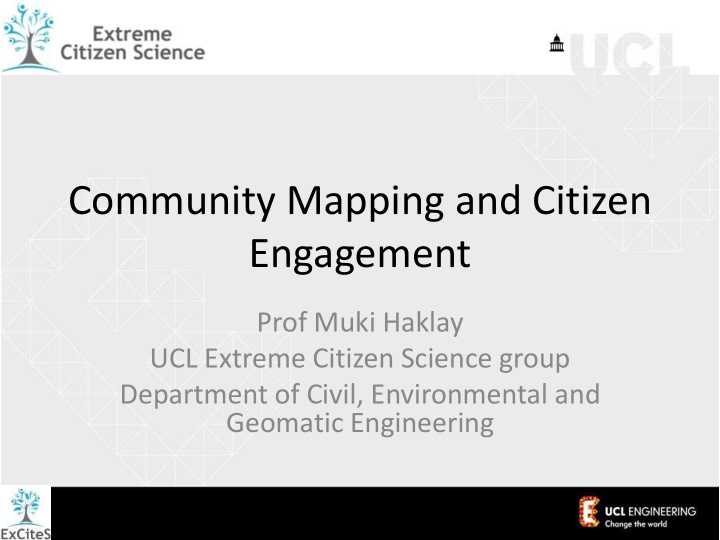



Community Mapping and Citizen Engagement Prof Muki Haklay UCL Extreme Citizen Science group Department of Civil, Environmental and Geomatic Engineering
Outline • Delivering mapping – communicating crime statistics • Participatory mapping and data collection • Participatory mapping in CPC
CamStats • Develop as part of a data sharing partnership between Camden Council, Police and NHS (project involving Dave Ashbey and Kate Jones) in 2003 • The needs and requirement were developed through consultation with representatives of the Camden community
London Green Map 2003
Web mapping 2.0 ChicagoCrime.org – one of the first Google Maps Mashups. Form of civic intervention in the use of geographic information held by the authorities
Paolo Isoardi, 2006, Creation of London 21 Green Map using Google Maps API
Rapid Appraisal Method • In-situ, multi-temporal • Good for accessing ‘hard -to- reach’ groups • Allows rapid scoping of local knowledge, concerns and possible solutions • Less control and discussion than focus group 21/05/2012 13 Steve Cinderby
Bottom Up Participatory GIS Google My Maps ability is used to create a Green Map for the Transition Town Brixton project
Ellul, C., Haklay, M. Francis, L. And Rahemtulla, H., 2009, A Mechanism to Create Community Maps for Non-Technical users , The International Conference on Advanced Geographic Information Systems & Web Services – GEOWS 2009
Mapping for Change • A social enterprise owned by University College London and the charity London 21 Sustainability network • Promoting and supporting community-based initiatives towards building more sustainable communities through the use of maps and geographic information • Specialising in participatory mapping & GIS application and connecting online and off line community engagement • Supporting geographical analysis in the third sector 21/05/2012 16
Introduction to existing public information Citizen Science and evidence gathering Discussion & Digitisation, initial priorities visualisation setting and discussion General perception mapping Website and online map At each stage in the process various mapping methods are used ranging from paper based exercises using large OS maps, web-based maps such as Google, our own Community Map website and also GIS packages. 21/05/2012 17
Introduction to existing public information Citizen Science and evidence gathering In each community, we start Digitisation, with a discussion about the Discussion & visualisation and initial priorities discussion official, public data that is setting available about their area General perception mapping Website and online map
Introduction to existing public information Citizen Science and evidence gathering A discussion leads to Digitisation, Discussion & visualisation and the list of issues that initial priorities discussion setting should be mapped and General the way they will be perception mapping mapped Website and online map
Introduction to existing public information Citizen Science and evidence gathering Digitisation, Discussion & visualisation and initial priorities discussion setting General perception mapping Website and online map Perception mapping focuses on questions such as: what aspects of your community you like or dislike? What problems do you want to solve?
Introduction to existing public information Citizen Science and evidence gathering Digitisation, Discussion & visualisation and initial priorities discussion setting General perception mapping Website and online map In some cases, perception mapping leads to focused evidence gathering, in other cases this is done directly after the discussion Noise measurements
21/05/2012 22
Archway Pedestrian Surveys were carried out in collaboration with Space Syntax who specialised in pedestrian movement analysis
Saturday 12:00 to 14:00 500 to 700 350 to 500 200 to 350 100 to 200 1 to 100 21/05/2012 25 Space Syntax
Introduction to existing public information Citizen Science and evidence gathering The paper maps from the Digitisation, perception mapping or Discussion & visualisation and initial priorities discussion from the evidence setting gathering are digitised. General perception That is done either mapping Website and offline – with a GIS – or online map online, on our community mapping site. Positive Youth or ASB Litter/Rubbish/Graffiti General Maintenance Safety Traffic/Transport/Parking Facility Improvements Other
Introduction to existing public information Citizen Science and evidence gathering The online map can Digitisation, continue and evolve over Discussion & visualisation and initial priorities discussion time. They are controlled setting by the community. General perception mapping Website and online map
Active CiTizenship and Social Housing The aim of this project is to explore which kind of informal learning contribution, in the context of social housing, could help to reinforce "social cohesion, active citizenship, intercultural dialogue, gender equality and personal fulfilment. 21/05/2012 28
Thamesmead mapping Thamesmead first began to take shape in the early 1960s when the-then London County Council (LCC) first published its plans to build 25,000 homes on Erith & Plumstead marshes. Mainly social housing developments built from the late 1960s onwards mostly on former marshland on the southern banks of the River Thames between the more established towns of Woolwich and Belvedere. Originally planned to have 60,000- 100,000 residents, it is now estimated to be on target for a final population of around 50,000 people
21/05/2012 30
21/05/2012 32
21/05/2012 33
21/05/2012 34
21/05/2012 35
21/05/2012 36
Source: Femi Adefemi Kingsley Adekunle UCL Geography 21/05/2012 37
• Follow us: – http://www.ucl.ac.uk/excites and http://www.mappingforchange.org.uk/ – Twitter: @UCL_ExCiteS @Mapping4Change – Blog: http://uclexcites.wordpress.com
Credits Support for the research kindly provided by : UCL Graduate School Research Fund, ESRC ‘Conserving Biodiversity That Matters: The Value of Brownfield Sites’ project Wandsworth council (pathfinder for e-government scheme) RGS/IBG Small Research Grant UrbanBuzz: Building Sustainable Communities (HEFCE) London Sustainability Exchange (LSx) London 21 Sustainability Network EPSRC Challenging Engineering Award ‘Extreme Citizen Science’ EPSRC Adaptable Suburbs project EU FP7 EveryAware project Google Research Awards Amazon Web Services Education Grants Special thanks to the participants and the communities that work with us And our partners: Royal Geographical Society, ESRI, Helveta and U-Blox
Recommend
More recommend